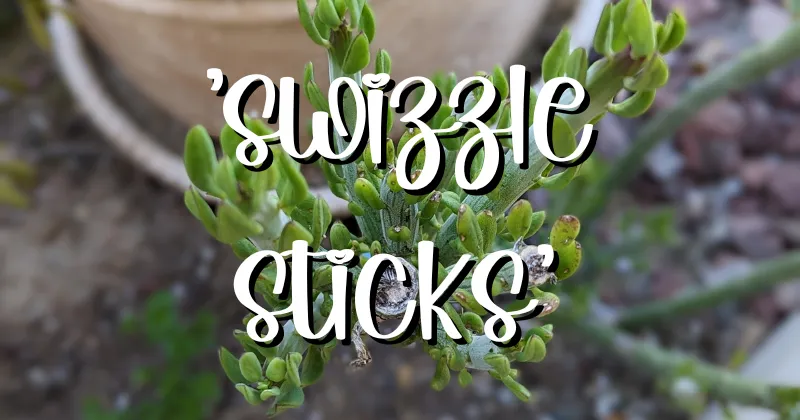Senecio anteuphorbium ‘Swizzle Sticks’ or ‘Cigar Plant’ is an interesting succulent plant from the Sahara desert in North Africa and the Middle East. This page will give you all the information you need to grow Senecio anteuphorbium ‘Swizzle Sticks’ successfully.
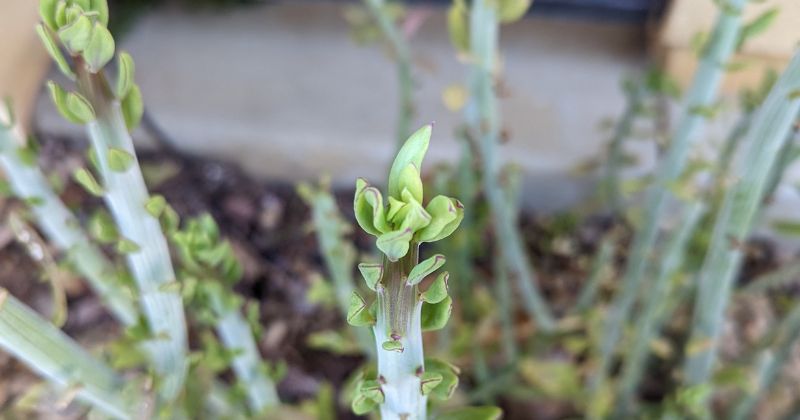
Care Guide Quick Links
Where ‘ Senecio anteuphorbium’ Swizzle Sticks Comes From
Senecio anteuphorbium ‘Swizzle Sticks’ grows naturally in the Sahara desert in North Africa and the Middle East. It is a summer-dormant bush that can grow up to 3 to 8 feet tall and wide, often forming messy thickets. Senecio anteuphorbium ‘Swizzle Sticks’ was one of the very first succulents grown by in Europe, planted since around 1570.
What Swizzle Sticks Looks Like
Stems
The stems of Senecio anteuphorbium ‘Swizzle Sticks’ are ascending or arching, long, round, and fleshy, up to 0.5 inches in diameter. They are pale greenish-grey, with lighter streaks and darker lengthwise lines. The stems are often heavily branched, giving the plant a “coral-like” appearance.
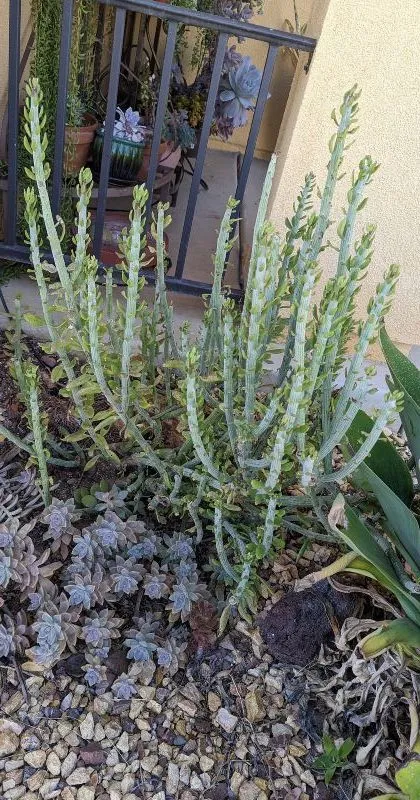
Leaves
The leaves of Senecio anteuphorbium ‘Swizzle Sticks’ fall off easily, clasp the stems at the branch tips. They are 0.2 to 0.6 inches long, 0.08 to 0.24 inches wide, and 0.08 inches thick, glaucous grey-green in color. Mine usually fall off in hot weather especially in the summer when it is dormant.
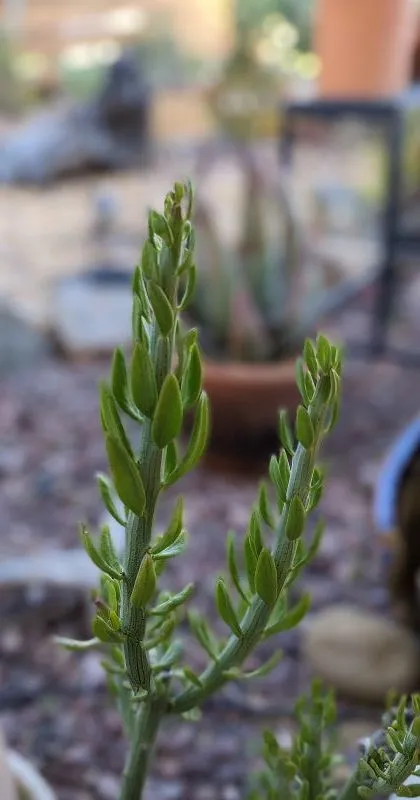
Flowers
The flowers of Senecio anteuphorbium ‘Swizzle Sticks’ are in terminal clusters of 3 to 7 flower heads, up to 0.8 inches across. The flowers have no petals, just yellow discs in the center, white or greenish, with pleasantly scented yellow anthers and stigmas. It usually blooms in the fall and winter.
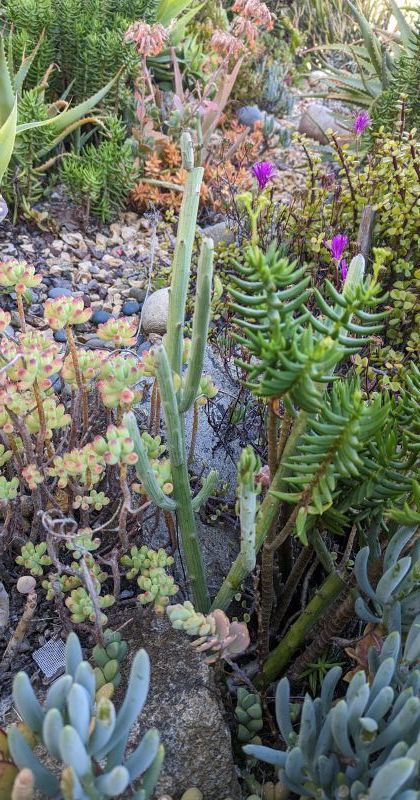
Growing Senecio anteuphorbium ‘Swizzle Sticks’
Soil
For Senecio anteuphorbium ‘Swizzle Sticks’, use soil that drains well, such as clay, pumice and lava grit, with a little peat moss or compost.
Mine are growing in very poor, clayey soil that I didn’t amend at all. I think I was out of succulent soil at the time. The thing is huge.
When growing it in pots, definitely use lots of inorganic amendments.
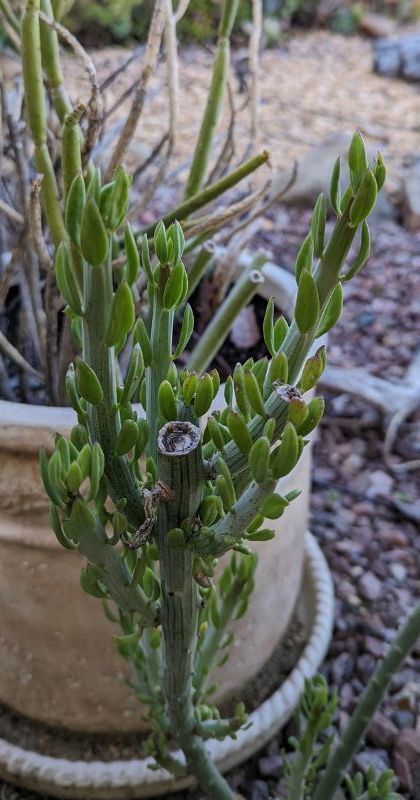
Growing in Pots
Use a pot with drainage holes and well-draining soil. A mix of perlite, pumice, and potting soil works well. This will prevent overwatering since ‘Swizzle Sticks’ is prone to root rot. Choose a pot that is at least 12 inches deep and wide. It has a spreading growth habit and branched stems, so it needs space for the roots to grow. Repot every 2-3 years in the spring. Look for roots peeking out the drainage holes to know when it’s time to move up one size.
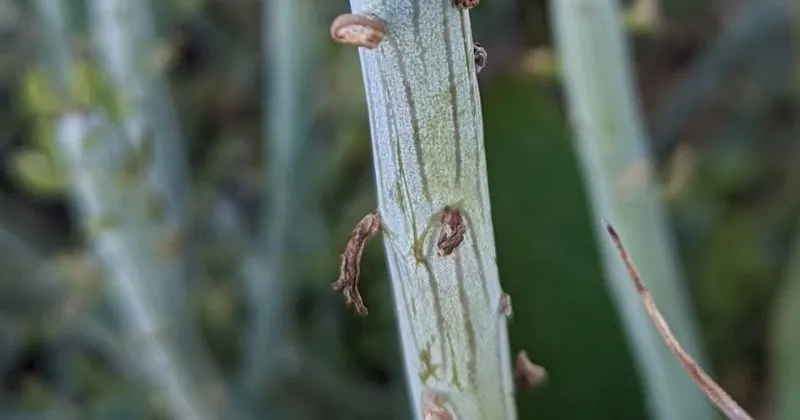
Fertilizing
Fertilize during the growing season. Use a balanced succulent fertilizer once a month from spring through summer according to the directions on the product packaging. If you forget to fertilize, it’s no big deal. They’re use to nutrient poor soil
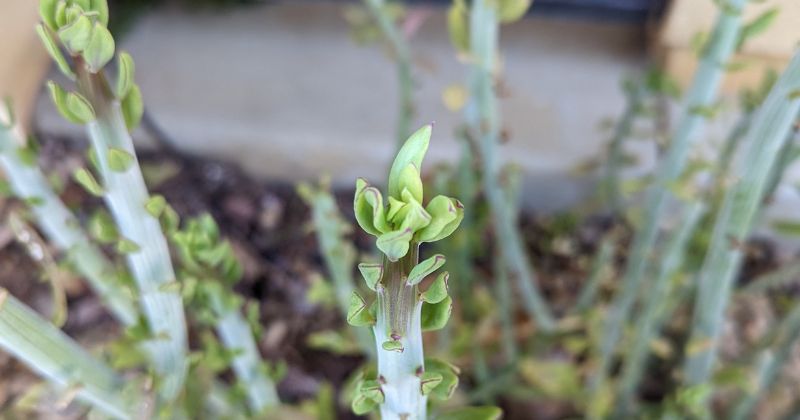
Water
Senecio anteuphorbium ‘Swizzle Sticks’ prefers to be on the dry side, so water thoroughly but infrequently, especially in hot weather. Water less in winter. Never leave water standing around the roots.
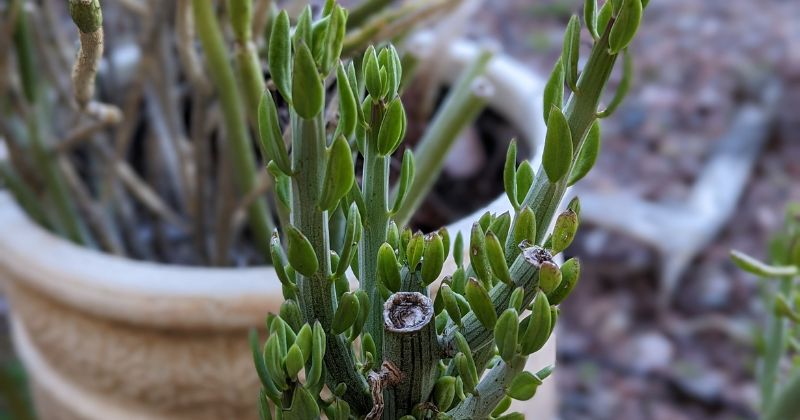
Hardiness
Senecio anteuphorbium ‘Swizzle Sticks’ can tolerate temperatures down to 23°F if kept very dry, but does best between 50-54°F. It can survive short light frosts when dry but is more prone to rot in cool, humid weather. Protect from intense frost. If temperatures are going below 23°F, move the pot into a sheltered spot, like a garage. Senecio anteuphorbium ‘Swizzle Sticks’ in pots are more at risk of damage from cold and freezing.
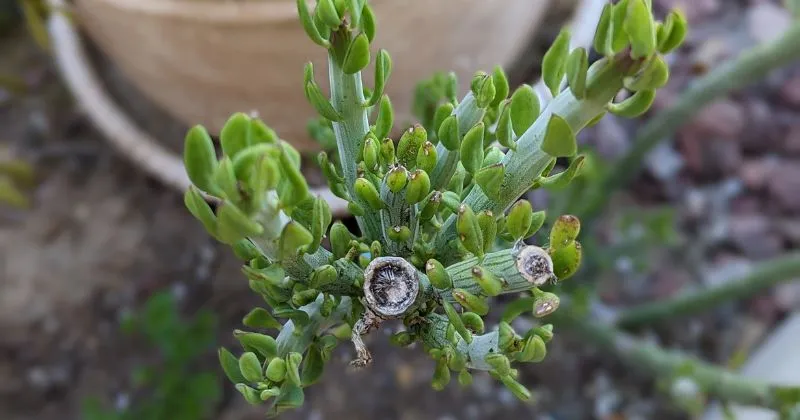
Sunlight
For best growth, give Senecio anteuphorbium ‘Swizzle Sticks’ full sun or filtered sun for at least 6 hours a day. It can get very leggy quickly even when outside in bright shade. I’ve never had any problems growing it in the full, hot sun in the ground or in pots.
Maintenance
Remove the flower stems after blooming. Senecio anteuphorbium ‘Swizzle Sticks’ can get leggy, especially in containers, so it may need yearly pruning.
Prune to control shape and size. You can prune Swizzle Sticks in a pot after flowering to promote new growth and maintain a compact shape.
Use sharp shears and cut stems back by about a third.
I recently pruned mine all the way back to the stump and in a couple of months, it has already grown back almost as big as it was when I pruned it.
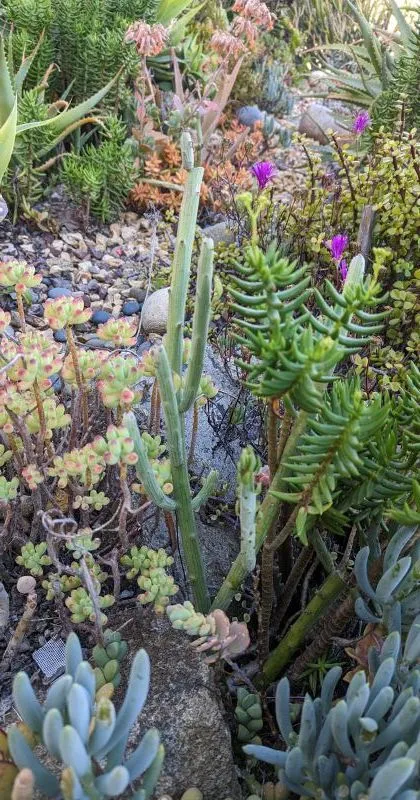
Propagation
Senecio anteuphorbium ‘Swizzle Sticks’ roots easily from cuttings. In late spring or summer, take a cutting, let it dry for 1-2 weeks, and plant in loose, well-draining soil. Set it and forget it and once it takes root you can start watering it as normal.
Where to Buy Senecio anteuphorbium ‘Swizzle Sticks’
Find it from Cactus Limon on Etsy by clicking the image below.
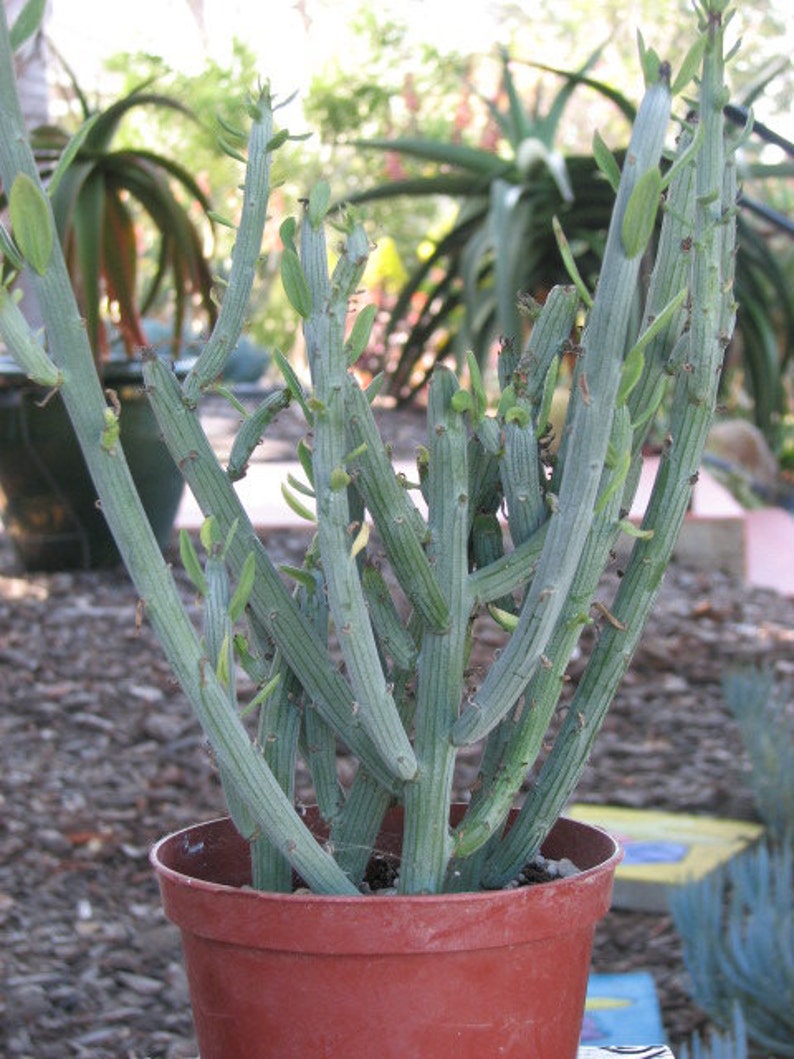
Common Pests and How to Treat them
- Mealybugs – Mealybugs are small, cottony pests that suck sap from the plant. They can infest new growth and the roots. Treat with alcohol spray, insecticidal soap or a systemic insecticide .
- Aphids – Green or black aphids may colonize new shoots and stems. They feed on sap and secrete honeydew which can lead to sooty mold. Treat with spray of water, insecticidal soap or neem oil.
- Scale – Scale are small hard or soft brown bumps that attach themselves to stems and leaves. They feed on sap and excrete honeydew. Treat by scraping them off manually with a blunt knife or apply insecticidal oil or soap.
- Spider Mites – Spider mites are tiny arachnids that spin fine webs on stems and leaves. They pierce cells and feed on sap, causing dotted, stippled damage. Increase humidity, spray with water, and apply insecticidal soap or predatory mites.
- Root Mealybugs – Root mealybugs are white cottony pests that infest roots, sucking sap and weakening the plant. Look for slow growth, yellowing and dropping leaves. Repot with fresh well-draining soil and treat roots with alcohol or insecticide drench.
- Fungus Gnats – Fungus gnats are small black flies that feed on algae and fungi in moist soil. Their larvae may feed on roots, damaging new growth. Treat by allowing soil to dry out, applying mosquito Bits or sand, and repotting with well-draining soil.
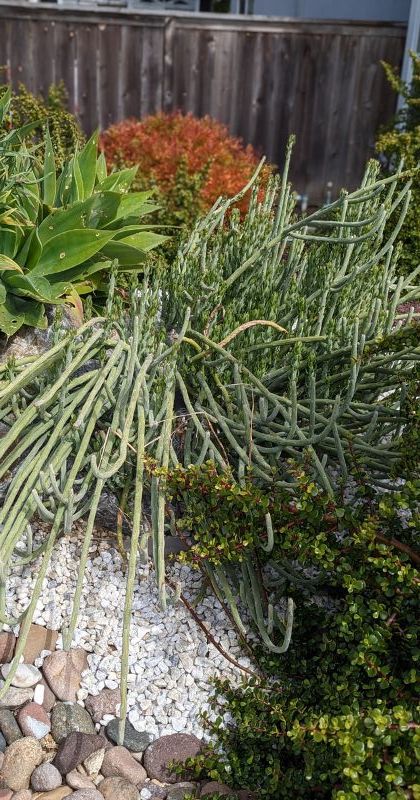
To prevent infestations in potted Swizzle Sticks
Use sterile, well-draining soil and only water when the top few inches are dry. Moist, humid conditions promote pest problems. Inspect plants regularly for any signs of pests or damage. Catching infestations early makes them easier to control. Isolate any new plants for a few weeks before placing near other plants. This prevents pests spreading to existing collections.
Repot and change part of the potting mix every 2-3 years. This disrupts any pests that may have infested the old soil. Place pots in a sheltered area with good air circulation. Avoiding extremes of heat or humidity will help keep potted Swizzle Sticks pest-free.
With the right care, Senecio anteuphorbium ‘Swizzle Sticks’ will reward you with its interesting look and sweetly scented flowers. You’ll be able to share cuttings with your succulent loving friends in almost no time at all! Follow this guide and you’ll do great with this fascinating succulent!

Where to Buy Succulents Online

